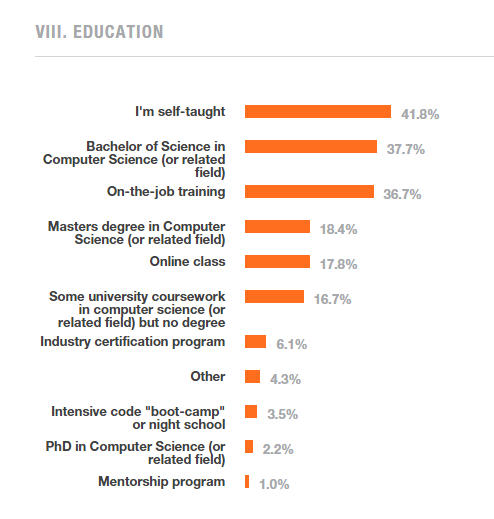Do jobs that require college, really require college?
America’s richest drop-out, Bill Gates, writes:
What many people may not realize is that America is facing a shortage of college graduates. That may not seem possible, especially for any graduate who is unemployed or underemployed. But here are the numbers: By 2025, two thirds of all jobs in the US will require education beyond high school.
Gates’s opinion represents the conventional wisdom: more-and-more jobs require college, and thus, we must double-down on efforts to push all Americans through college.
It is possible that Gates is technically correct. Perhaps in 2025, on paper, two thirds of jobs will demand a college diploma.
But is this demand for a college diploma a natural requirement based on the characteristics of current jobs? Or is it an artificial demand – the result of credentialing laws or degree inflation?
I have long suspected that a college education is not an innate requirement for the vast majority of jobs. There are many famous high achievers who lacked higher education: Abraham Lincoln, Mark Twain, Thomas Edison, and Bill Gates himself. But of course, these could be outliers.
So I decided to do a more systematic study. I picked six professions, and for each profession selected a representative sample of a dozen or so people who were eminent during the mid-to-late 19th century.
- For architecture I picked 10 of my favorite buildings from the 19th century, and then looked up the biographies of the 17 architects.
- For civil engineering, I picked the first dozen presidents of the American Society of Civil Engineers who had a biography.
- For law, I picked every Supreme Court Justice who sat between 1830 and 1870.
- For mechanical engineering, I found a list of famous 19th century inventions and picked out fifteen inventors.
- For business executives, I found a list of the “robber barons” from wikipedia.
- For writers, I found a list of the best American novels.
In total, only 34% of all these accomplished knowledge workers graduated college. And many of these graduates finished schooling before they reached 20 years of age. Meanwhile 36% of these professionals dropped out before even obtaining a high school diploma. The least schooled were the architects, mechanical engineers and the business tycoons. The most schooled were the civil engineers.1
Let us go through each profession, see how it breaks down, and learn about how people came to their profession before college was the universal requirement.
19th Century Architects
I looked up a dozen of my favorite buildings from the 1800s, and tracked down the 17 architects who were listed as designers. These architects represent the preeminent masters of their time. The buildings are still the pride of their cities. The formal schooling breakdown is as follows:
- Only one-third (6 of 17) had a college degree. Those with degrees generally graduated at a young age – for example, Gilman at 19, Root at 19, Renwick at 19, Bullfinch at 18.
- One-third had no formal art, engineering or architectural schooling whatsoever. They went straight from local schooling to apprenticing as drafters for an established architect.
- The other third had either a year of college, or spent time in an atelier. An atelier was a hybrid studio and place of learning.
Here is a sample showing the buildings drop-outs designed and how they came into the profession:
Thomas Ustick Walter
Born in 1804 in Philadelphia, Walter was the son of mason and bricklayer Joseph S. Walter and his wife Deborah. Walter received early training in a variety of fields including masonry, mathematics, physical science, and the fine arts. At 15, Walter entered the office of William Strickland, studying architecture and mechanical drawing, then established his own practice in 1830.
Walter was the fourth architect of the U.S. Capitol and the one who gave it its iconic dome.
Walter worked with his partner McArthur (also an architect with no formal schooling) to design the Philadelphia City Hall. It set a world-record for height and is still one of the most epic buildings in America:
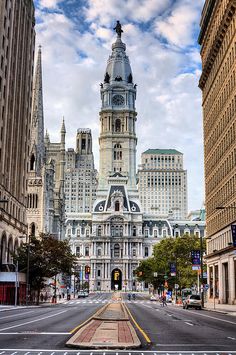
Louis Sullivan
Louis Henry Sullivan was born to a Swiss-born mother and an Irish-born father, Patrick Sullivan, both of whom had immigrated to the United States in the late 1840s. Learning that he could both be graduated from high school a year early and pass up the first two years at the Massachusetts Institute of Technology by passing a series of examinations. Entering MIT at the age of sixteen, he studied architecture there briefly. After one year of study, he moved to Philadelphia and took a job with architect Frank Furness.
Sullivan moved on to Chicago in 1873 to take part in the building boom following the Great Chicago Fire of 1871. He worked for William LeBaron Jenney, the architect often credited with erecting the first steel-frame building. After less than a year with Jenney, Sullivan moved to Paris and studied at the École des Beaux-Arts for a year. He returned to Chicago and began work for the firm of Joseph S. Johnston & John Edelman as a draftsman. Johnston & Edleman were commissioned for the design of the Moody Tabernacle, with the interior decorative “fresco secco” stencils (stencil technique applied on dry plaster) designed by Sullivan. In 1879 Dankmar Adler hired Sullivan. A year later, Sullivan became a partner in the firm. This marked the beginning of Sullivan’s most productive years.
One of the most famous American architects, Sullivan thus had one year of college in total (and later one year at the Paris atelier), and was working full-time at age 17. He was partner of his firm at age 23, when a modern architectural student would just be starting graduate school.
He mastered the new technology of building steel-framed building, and designed some of the first Skyscrapers. Not only that, his buildings were renowned for their gorgeous detail and ornament:

Frank Lloyd Wright
Soon after Wright turned 14, his parents separated. Anna had been unhappy for some time with William’s inability to provide for his family and asked him to leave. As the only male left in the family, Wright assumed financial responsibility for his mother and two sisters. Wright attended Madison High School, but there is no evidence he ever graduated. He was admitted to the University of Wisconsin–Madison as a special student in 1886. There he joined Phi Delta Theta fraternity, took classes part-time for two semesters, and worked with a professor of civil engineering, Allan D. Conover. In 1887 [at age 20], Wright left the school without taking a degree and arrived in Chicago in search of employment. Within days, and after interviews with several prominent firms, he was hired as a draftsman with the architectural firm of Joseph Lyman Silsbee.
Wright is known for his prairie houses, which was an entirely new, entirely American style of architecture:
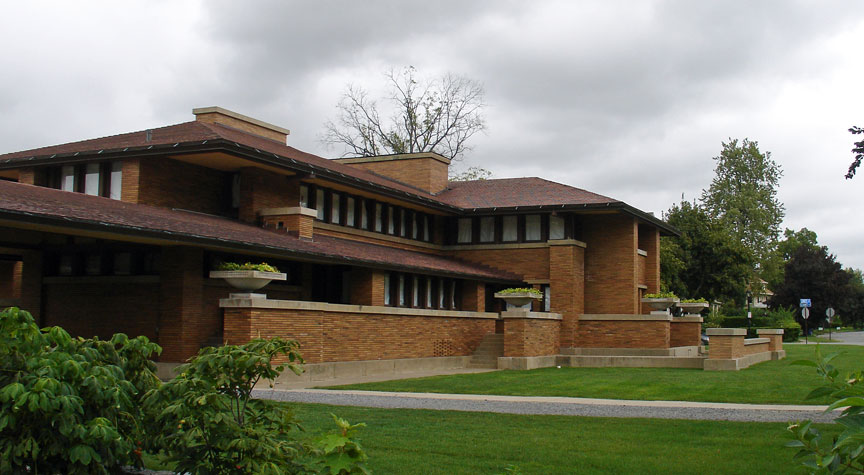
Modern architects
Compare the work of those unschooled architects, to the iconic works of highly credentialed architects of today.
Here are three buildings I have come across recently. These buildings were commissioned as expensive, prestige buildings and won awards by the professional associations.
The first building was developed by the firm of Erdy and McHenry. Erdy has a bachelors and a masters in architecture, McHenry has a bachelors and an MBA. Both principals lecture at Penn:
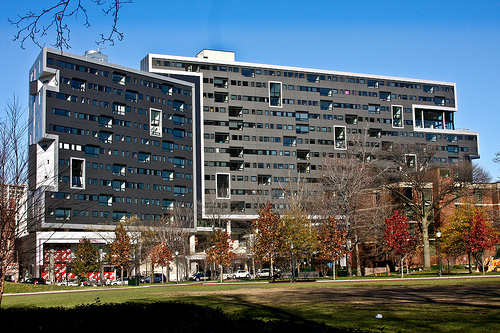
It looks even worse when you are street-side:

Modern architects are allergic to ornament, yet ornament is the most straight-forward way to make a building look good up close. Otherwise you just see sterile, barren concrete.
The second building is MIT’s Simmons Hall. It was one of their most expensive dorms to construct. It won the 2004 Harleston Parker Medal, administered by the Boston Society of Architects and awarded to the “most beautiful piece of architecture building, monument or structure” in the Boston area. Sometimes I wonder if I am insane or the rest of the world is insane. Then I look at a building like this getting an award for beauty, and say, nope, it is the rest of the world that is insane, I’m the sane one:

The architect was well schooled though. Steven Holl got a bachelors from the University of Wisconsin and did graduate work in London at the Architectural Association School of Architecture.
The third building is Boston’s City Hall. It also won awards when it was built. Gerhard Kallmann studied at the Architectural Association School of Architecture and then was a professor at Columbia. He submitted the design along with his Columbia graduate student Michael McKinnel.
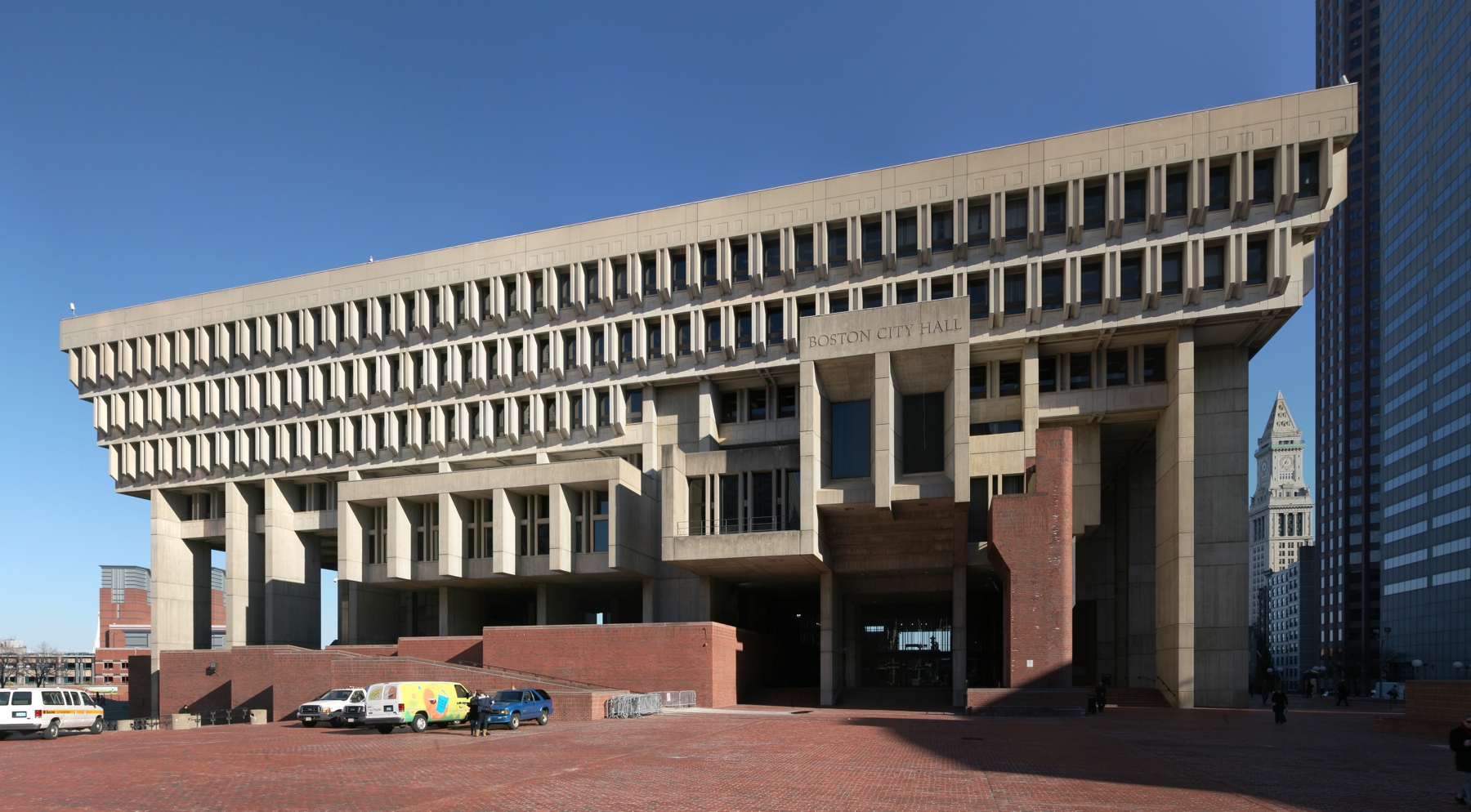
When Boston’s mayor at the time first saw the model, he reportedly gasped and said, “What the hell is that?” But of course, Mayor Collins did not go to an Ivy League school, so clearly he was not enlightened enough to understand the beauty of the design.
The true nature of architecture schooling
The horribleness of these buildings is no accident. Rather, decades ago the architecture departments were taken over by crazy Stalinist academics who actively mis-educate students. I mean “Stalinist” with no hyperbole intended. The architect who inspired the infamous and ugly concrete buildings of communist Eastern Europe – Walter Gropius – ended up running the Harvard architecture department. Author Michael Jones describes his background:
One of the most influential members of the New World clerisy when it came to modern architecture and urban planning was the German émigré and cultural Bolshevist Walter Gropius, who arrived to take up the reins of leadership at the Harvard School of Architecture at the same time that Walter Phillips was assembling the “clever few” in Philadelphia. Throughout the 1930s, Gropius would proselytize for his vision of worker housing - thirteen-story machines for living which would facilitate the new social arrangements that modern science was then making possible. This entailed the abolition of the family as well as the assumption into large communal cafeterias of much of what got done in the traditional home. Much of Gropius’s vision got implemented in Communist bloc countries after World War II. His lieutenant and successor at Bauhaus Dessau, Ernst May, actually emigrated to Moscow in 1933 to put that vision into effect there.
In July of 1933, Gropius was back in the Soviet Union, again railing against what he now called “the immoral right of private property”:
“Without the liberation of the land out of this private slavery it is impossible to create a healthy, development-capable urban renewal that is economic in terms of society in general. Only the Soviet Union has fulfilled this most important requirement without reservation, and thereby opened the way for a truly modern urban planning.”
Four years after he made this speech, Gropius was chairman of the architecture department at Harvard. From then on he refrained from using phrases like the “immoral right of private ownership.” Instead, he talked about things like “our belief in democratic government.”
(source: Slaughter of the Cities by Michael Jones, page 82)
Here are a few of the buildings and cities that Gropius’s proteges designed in Soviet Russia:
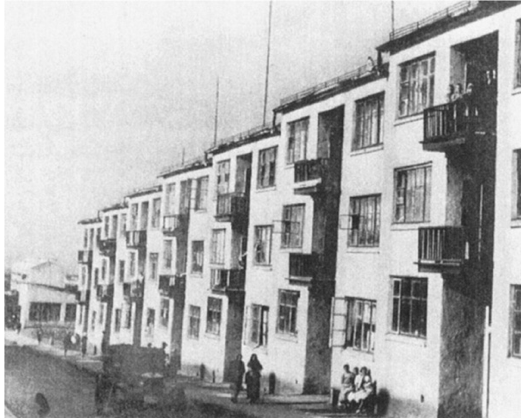

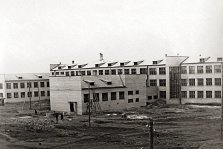
And here a few buildings Gropius designed for the Harvard campus:
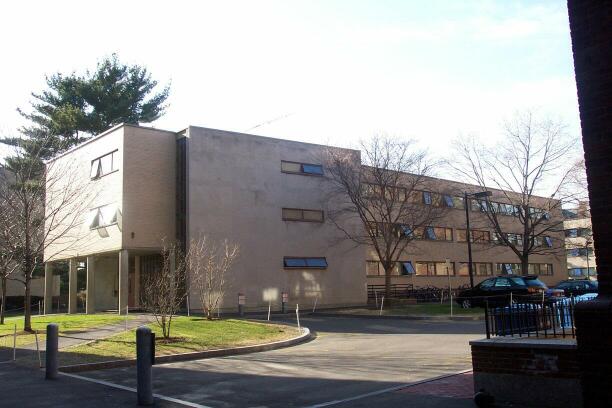

If you think I am cherry-picking, just walk around any college or any old city. The buildings built after the 1940s are immediately discernible from the buildings built prior. It is hard to think of a single building built in Philadelphia in the last forty years, that would make a top twenty list of buildings built from 1870 to 1910.
My significant other attended an Ivy League architecture school, and I ended up spending up a great deal of time among her classmates. A few observations:
1) The schools are obsessed with novelty. No longer do they teach how to do beautiful styles. They do not teach pattern books, nor the time tested methods of building facades that will be tasteful and attractive for decades to come. Instead they are obsessed with the latest fad. In the 60s that was brutalism, most recently, it has been algorithmic design. Many projects looked like this:

2) The schools do not actually teach the practical and structural knowledge needed to create real, sturdy buildings. After students graduate, they have to spend hundreds of hours cramming for the exams to get licensed. Then, on the job, they learn a million practical details: designing with real world materials, complying with regulations, and dealing with everything from HVAC systems to structural loading. The entire theory of requiring an architectural degree is that you want someone prepared to build buildings that won’t fall down or poison their residents – but the schools proportionally spend a minuscule amount of time on such matters.
3) One theory is that buildings are more complicated now, and thus require more education. But this is not so. My significant other is amazed at some of the ways they built things a hundred years ago and was never taught how build using those methods. Designing with steel is different than with masonry, but does not obviously require more years of schooling.
4) A masters degree is a hard requirement for becoming a licensed architect. It used to be that work experience could be used as a substitute, but that alternative path was gradually rolled back.
A hundred years ago an ambitious, but poor young lad could find a job as a drafter and work his way up. By his mid 20s he would be designing beautiful buildings, without any debt for college or graduate school. Today, this same lad would have to pay upwards of $250k to be miseducated, and end up designing buildings far inferior in aesthetics.
So much for architecture. Let’s move on to lawyers.
Educating a Supreme Court Justice
I did an inventory of every Supreme Court Justice who served between 1835 and 1870. Among them:
- 2 of 18 went to Law School. One graduated at age 20, the other at age 22.
- 11 of 18 graduated college, of those four graduated at the age of 18.
- 7 of the 18 had no college, they were either self-taught or had an apprenticeship.
Here a few example backgrounds of the unschooled justices:
John McClean
McClean worked on his parents’ farm in Ohio until he was 16. At that age he received his first formal education in a local school, where he studied classics for two years. In 1804 [age 19] McLean was apprenticed to the clerk of the Court of Common Pleas of Hamilton County. During that time he studied law under Arthur St. Clair Jr., one of Ohio’s leading lawyers. McLean was admitted to the bar in 1807.
John Catron
Modest family circumstances deprived John Catron of a private education, and such knowledge as he managed to acquire was self-taught. He studied law briefly before undertaking military service for Tennessee and eventually serving under General Andrew Jackson during the War of of 1812. After this military career he resumed legal studies and was admitted to the practice of law in 1815…The story is told in the diary of S.H. Laughlin that Catron was passing through McMinnville, Tennessee on one occasion in 1812 and saw a copy of Blair’s Rhetoric on a counter of Buchanan & Laughlin’s store. Although without ready cash, he arranged to buy the book on credit and returned later and paid the purchase price. Those familiar with that textbook know that it was used in the colleges for advanced study of the English language. Schools were few and far between in the western country in those days, and it is no small wonder that young Catron was able to attain enviable proficiency in history, geography and literature. The Bible, being the daily reader in the early schools, was thoroughly absorbed by the student.
Noah Haynes Swayne
Swayne was born in Frederick County, Virginia in the uppermost reaches of the Shenandoah Valley, approximately 100 miles (160 km) northwest of Washington D.C. He was the youngest of nine children of Joshua Swayne and Rebecca (Smith) Swayne. After his father died in 1809, Noah was educated locally until enrolling in Jacob Mendendhall’s Academy in Waterford, Virginia, a respected Quaker school 1817-18. He began to study medicine in Alexandria, Virginia, but abandoned this pursuit after his teacher Dr. George Thornton died in 1819. Despite his family having no money to support his continued education, he read law under John Scott and Francis Brooks in Warrenton, Virginia, and was admitted to the Virginia Bar in 1823.
Schooling and Law
Once again, the requirement for a law degree was a result of legal changes. The bar associations in 49 states have eliminated the apprenticeship and self-study option for becoming a lawyer.
If Supreme Court Justices could once self-study to pass the bar, why cannot an ordinary modern lawyer do the same? The stories above make the idea of school or college being the ladder to opportunity into a cruel joke. It was far easier for someone like Noah Swayne to study via self-study and apprenticeship, when his family had no money, than it would have been for him to spend four years at college and three at law school. But now such a path is legally prohibited. It has been cut-off. Law school deans who wax philosophical about the value of college are like some bully who has stolen $10 from you, then allow you to mow their lawn to get it back.
One may say “but the law is more complicated today, people need more schooling.” This argument fails at least four different ways:
- A traditional response to the growing scope of a field is to specialize. A divorce lawyer does not need to study corporate finance law.
- My lawyer friends have told me that law school does not actually teach much practical law. Professors and classes are generally far removed from actual case work. Practical legal knowledge is learned on the job, and it takes years of actually doing it to become a good lawyer.
- Rather than spend enormous time and effort educating people to keep up with an increasingly byzantine legal system, would not the proper response be to greatly simplify the law?
- Even if more knowledge is needed today, shouldn’t a lawyer be allowed to gain that knowledge through self-study? Why is paying a gate-keeper a legal requirement?
Business Tycoons
I found on Wikipedia a list of twenty-eight 19th century tycoons. These businessmen engaged in complex financial transactions, oversaw large chains of supply and production, and pioneered new methods of sales and marketing. They virtually all had less formal education than the modern “business” graduate who accumulated 12 years of grade school and 4 to 6 years of university. Their education breakdown was as follows:
- 13 of 28 had only grade school or less for education
- 3 of 28 graduated high school, but had no college
- 9 had some “college”
- 2 graduated college
- 1 graduated college and went to law school
I put college in quotes because these were often just a few classes, taken at a young age. For instance, Rockefeller studied bookkeeping at college when he was in his mid-teens, and then started his career:
Rockefeller attended Cleveland’s Central High School, the first high school in Cleveland and the first free, public high school west of the Alleghenies. Then, he took a ten-week business course at Folsom’s Commercial College, where he studied bookkeeping. In September 1855, when Rockefeller was sixteen, he got his first job as an assistant bookkeeper working for a small produce commission firm called Hewitt & Tuttle. He worked long hours and delighted, as he later recalled, in “all the methods and systems of the office.” He was particularly adept at calculating transportation costs, which served him well later in his career.
Other example backgrounds:
At age 14, John Cleveland Oswgoodn was on his own, working in the office of a cotton mill where he gained business knowledge. He left for New York City at age 16 and clerked for a Produce Exchange Commission firm while attending night school. After three years there, he returned to southeast Iowa as cashier of the White Breast Fuel Company, then learned the banking business as cashier of the First National Bank of Burlington. At age 26, he took over the White Breast Fuel Company.
After finishing a two-year course at Philadelphia’s Central High School, Yerkes began his business career at the age of 17 as a clerk in a local grain brokerage. In 1859, aged 22, he opened his own brokerage firm and joined the Philadelphia stock exchange.
As a young boy, Edward Henry Harriman spent a summer working at the Greenwood Iron Furnace in the area owned by the Robert Parker Parrott family that would become Harriman State Park. He quit school at age 14 to take a job as an errand boy on Wall Street in New York City. His uncle Oliver Harriman had earlier established a career there. By age 22, he was a member of the New York Stock Exchange.
Cornelius Vanderbilt was born in Staten Island, New York, to Cornelius van Derbilt and Phebe Hand. He began working on his father’s ferry in New York Harbor as a boy, quitting school at the age of 11. At the age of 16 Vanderbilt decided to start his own ferry service.
Civil Engineers
I went to Wikipedia and looked up the first 15 presidents of the American Society of Civil Engineers. These men built some of the great works that laid the foundation of American greatness: the Erie Canal, the Chicago Water Works, the Washington sewer system, the Fort Pitt Foundry that produced artillery for the Civil War, the first bridge across the Missouri River.
Of these, 10 graduated college, and 5 did not. Of those who graduated, ages ranged from 19 to 22.
Ellis S. Chesbrough
His father met with business reverses, and the boy was taken from school at the age of thirteen and became chainman to an engineering party engaged in the preliminary survey of the Baltimore and Ohio railroad. Later he was engaged on the Allegheny and Portage railroad, and in 1831 became associated with William Gibbs MeNeill in the construction of the Paterson and Hudson River railroad. In 1837 he was appointed senior assistant on the building of the Louisville, Cincinnati, and Charleston railroad, and in 1846 became chief engineer of the Boston water-works, planning the important structures on it, including the Brookline reservoir.
William Milnor Roberts
In 1826 [age 16], he served as an assistant in survey and construction, Lehigh Canal, between Mauch Chunk, Pennsylvania and Philadelphia. From 1831 to 1834, he served as senior assistant engineer for the proposed Allegheny Portage Railroad, and general manager from 1834 to 1835. In 1837, he served as chief engineer, Lancaster and Harrisburg. He was in charge of construction of a two-level lattice-truss bridge across the Susquehanna River at Harrisburg, Pennsylvania.
James Francis
James Francis was born in South Leigh, near Witney, Oxfordshire in England, United Kingdom. He started his engineering career at the early age of 14 as he worked as his father’s apprentice at the Port Craw Railway and Harbor Works in South Wales. When he turned 18, he decided to emigrate to the United States, in 1833. His first job was in Stonington, Connecticut as an assistant to the railway engineer George Washington Whistler Jr., working on the New York and New Haven Railroad. A year later, James and his boss, Whistler, travelled north to Lowell, MA, where at the age of 19, he got a draftsman job with the Locks and Canal Company, and Whistler became chief engineer.
Octave Chanute
Immigrating to the United States with his father in 1838, Chanute attended private schools in New York City. His first job was as a member of a surveying crew with the Hudson River Railroad. He then worked his way up through a series of increasingly responsible engineering positions on western railroads. In addition, he served as chief engineer on a variety of important projects, notably the construction of the first bridge across the Missouri River.
It is now commonplace in histories to mock the Horatio Alger stories of some poor pauper working his way up from the mail room all the way to being a millionaire corporate tycoon. And of course, very few people ever become rich barons. But what was much more common was to start penniless as a teenager as a low-level technician or laborer, and then work oneself up into a solid career as a highly skilled professional. Once again, the idea that all professional advancement can only be come through college, the idea that either you go to college or are stuck at some menial position, is an artificial construction of today’s world.
Mechanical Engineers and Inventors
I made a list of fifteen of the most important and impressive inventions before World War I: the cotton gin, the revolver, the sewing machine, the gas engine, the steam turbine, the airplane, the mechanical reaper, the radio, etc. Of the 18 inventors involved, 11 of 18 had a grade school education or less, 1 had a high school diploma, 6 others graduated college.
Robert William Thomson
Thomson patented the pneumatic rubber tire:
Born in Stonehaven in the north east of Scotland, Robert was the eleventh of twelve children of a local woollen mill owner. His family wished him to study for the ministry but Robert refused, one reason being his inability to master Latin. He left school at the age of 14 and went to live with an uncle in Charleston, United States, where he was apprenticed to a merchant. Two years later he returned home and taught himself chemistry, electricity and astronomy with the help of a local weaver who had a knowledge of mathematics.
Samuel Colt
Samuel Colt invented the famous 6-shooter revolver:
At age 11, Colt was indentured to a farmer in Glastonbury, where he did chores and attended school. Here he was introduced to the Compendium of Knowledge, a scientific encyclopedia that he preferred to read rather than his Bible studies. Its articles on Robert Fulton and gunpowder motivated Colt throughout his life. He discovered that other inventors in the Compendium had accomplished things that were once deemed impossible, and he wanted to do the same. Later, after hearing soldiers talk about the success of the double-barreled rifle and the impossibility of a gun that could shoot five or six times without reloading, Colt decided that he would create the “impossible gun”.
George Stephenson
Stephenson, born of poor and illiterate parents, rose up the ranks via talent, and ended up building one of the first steam locomotives:
George Stephenson was born on 9 June 1781 in Wylam, Northumberland, 9 miles (15 km) west of Newcastle upon Tyne. He was the second child of Robert and Mabel Stephenson, neither of whom could read or write. Robert was the fireman for Wylam Colliery pumping engine, earning a very low wage, so there was no money for schooling. At 17, Stephenson became an engineman at Water Row Pit in Newburn. George realised the value of education and paid to study at night school to learn reading, writing and arithmetic – he was illiterate until the age of 18. In 1801 he began work at Black Callerton Colliery as a ‘brakesman’, controlling the winding gear at the pit. In 1802 he married Frances Henderson and moved to Willington Quay, east of Newcastle. There he worked as a brakesman while they lived in one room of a cottage. George made shoes and mended clocks to supplement his income….In 1811 the pumping engine at High Pit, Killingworth was not working properly and Stephenson offered to fix it. He did so with such success that he was promoted to enginewright for the collieries at Killingworth, responsible for maintaining and repairing all the colliery engines. He became an expert in steam-driven machinery. Stephenson designed his first locomotive in 1814, a travelling engine designed for hauling coal on the Killingworth wagonway. The locomotive could haul 30 tons of coal up a hill at 4 mph (6.4 km/h), and was the first successful flanged-wheel adhesion locomotive: its traction depended on contact between its flanged wheels and the rail.

Eli Whitney
Eli invented the cotton gin. His family could not afford Yale, so he worked as a teacher and farm laborer to save up enough and then went to school a bit later in life:
Whitney’s mother, Elizabeth Fay, died in 1777, when he was 11. At age 14 he operated a profitable nail manufacturing operation in his father’s workshop during the Revolutionary War.
Because his stepmother opposed his wish to attend college, Whitney worked as a farm laborer and school teacher to save money. He prepared for Yale at Leicester Academy (now Becker College) and under the tutelage of Rev. Elizur Goodrich of Durham, Connecticut, he entered the class of 1789 and graduated Phi Beta Kappa in 1792. Whitney expected to study law but, finding himself short of funds, accepted an offer to go to South Carolina as a private tutor.
19th Century Writers
Starting with Edgar Allen Poe and going until 1900, I gathered twenty authors of famous novels from this list. Among these authors:
- 6 had only had grade school or less
- 3 were educated via private tutors or had a professor for a father
- 3 graduated high school
- 5 had some college, but did not finish
- 3 graduated college
Here are a few bios of those who had little schooling:
Mark Twain
Mark Twain is perhaps the most renown American writer of the 19th century. He never made it past the fifth grade:
In 1847, when Twain was 11, his father, by then an attorney and judge, died of pneumonia. The next year Twain left school after the fifth grade to become a printer’s apprentice. In 1851, he began working as a typesetter and contributor of articles and humorous sketches for the Hannibal Journal, a newspaper Orion owned. When he was 18, he left Hannibal and worked as a printer in New York City, Philadelphia, St. Louis, and Cincinnati. He joined the newly formed International Typographical Union, the printers union, and educated himself in public libraries in the evenings, finding wider information than at a conventional school.
George Lippard
George Lippard is most famous for The Quaker City, the Monks of Monk Hall, which was the best selling novel in America before Uncle Tom’s cabin:
Young Lippard grew up in Philadelphia, in Germantown (presently part of the city of Philadelphia), and Rhinebeck, New York (where he attended the Classical Academy). After considering a career in the Methodist religious ministry and rejecting it because of a “contradiction between theory and practice” of Christianity, he began the study of law, which he also abandoned, as it was incompatible with his beliefs about human justice. Following the death of his father in 1837 [at age 15], Lippard spent some time living like a homeless bohemian, working odd jobs and living in abandoned buildings and studios. Life on Philadelphia’s streets gave him firsthand knowledge of the effects the Panic of 1837 had on the urban poor. Distressed by the misery he witnessed, “Lippard decided to become a writer for the masses”
Harold Frederic
Frederic is most famous for The Damnation of Theron Ware in 1896, which was a best-seller. Biographers wrote of the novel, “If this were the only novel Frederic had written, it would still be enough to place him alongside writers like Nathaniel Hawthorne, Mark Twain, Henry James, William Dean Howells, and Stephen Crane in the nineteenth-century American canon.” Here was his career path:
Frederic was born in Utica, New York, to Presbyterian parents. After his father was killed in a railroad accident when Frederic was 18 months old, the boy was raised primarily by his mother. He finished school at age fifteen, and soon began work as a photographer. For four years he was a photographic touch-up artist in his hometown and in Boston. In 1875 he began work as a proofreader for the newspaper The Utica Herald and then The Utica Daily Observer. Frederic later became a reporter. Frederic married Grace Green Williams in 1877, and they had five children together. By 1882 he was editor of the newspaper The Albany Evening Journal in the state capital.
Now that we have given an overview of how it used to be, let me ask and answer some key questions.
If a college degree is not required for these professions, why are so many people paying $250,000 for college and law school?
In the 1800s, there was no degree requirement to become a lawyer in most states. Some states required an apprenticeship. In other states a person could simply self-study and pass the bar exam. In the early 1900s more and more state bar associations began to require degrees. At first, people got around this by taking correspondence courses (MOOC’s are nothing new). But the accreditation requirements were changed to require expensive, in-person schools.
A similar story exists in other fields. A wide variety of high-paying professions now require a degree either by law or internal policy: All these professions now have a hard requirement: lawyer, doctor, nurse, teacher, commissioned military officer, parole officer, many civil servant positions, education administrator, lab assistant. If you are 18 years old and uncertain of your future, it makes sense to get a degree so that you have the option of pursuing one of these high-paying professions.
A second reason for the rise of college is that anti-discrimination laws made alternative mechanisms of screening candidates perilous. The Griggs v. Power case made it basically illegal to use IQ tests for hiring. If companies use more subjective screens in interviews, and the results do not have the proper racial balance, the company exposes itself to a disparate impact lawsuit. Thus, the path of least resistance for HR departments is to make a blanket college degree requirement, since this is always seen as an acceptable screening mechanism by the courts. Instead of submitting IQ test results directly, students take an IQ test to get into college (the SAT), and the company screens based on degree. Colleges have the legally privileged position of being IQ test launderers.
The third reason for the increase in college is that more and more the best jobs are politically connected bureaucratic and regulatory jobs (or jobs with companies that must comply with regulations). Employers need to know that you have assimilated the latest zeitgeist. McKinsey, JP Morgan, et al, want employees who they can trust to say “Asian-American” instead of “Orientals”, who they can trust not to make wisecracks when discussing transgendered bathrooms, and who otherwise are on top of the latest fashions in speech and thinking.
The fourth reason is that college for many people has become four years of government subsidized fun and partying. There is a long list of subsidies, tax breaks, and special legal privileges that colleges possess. College has historically been a luxury good. We are richer as a nation now, so more people want this good, especially if it is subsidized.
The fifth reason is that once all the intellectual taste-makers have degrees, then their output will reinforce the idea that a college degree is high status and marks you as a better person. The educational-industrial complex supports this same message by teaching everyone how essential school is. Thus with everyone from our 8th grade teacher to the latest sitcom father promoting college, the importance of college gets embedded deep into our psyche.
These factors have all combined to create a feedback loop: most smart, diligent people find it wise to go to college, and therefore, most employers will not even bother searching elsewhere for new hires. It is simply easier to hire college graduates than to try to find a hidden gem among people who skipped college. This creates more incentive for strivers to go to college in order to get access to jobs and network with other strivers. People who do not go to college are seen as losers and weirdos. With a higher percentage of strivers in college, the feedback loop grows stronger as companies have yet more incentive to rely on college degree as the initial screen.
Objections and Responses
When I have argued this topic, I get a few common objections:
I found my college to be very valuable. I was exposed to a wide array of thinkers, learned many valuable skills. Much of what I learned is very valuable in my profession.
I am not arguing that college is always useless. I am arguing that it is not intrinsically required. And for most people it is not the most cost-efficient way to gain needed career skills. In most professions, the most efficient path would be to read library books or do a paid apprenticeship while studying on the side. Even when having a teacher is better than self-study, very little of college tuition goes toward instruction.
Are you saying Doctors should not need any medical school? Are we go to back to the 19th century practice of the barber doing surgery? How do you feel about leeches and blood letting? Are you crazy?
No, barbers should not do surgery. There are some professions where formal schooling is necessary, because book learning is insufficient. There are practical aspects that are too risky to learn on the job. Aspiring doctors certainly need to attend medical school in order to do labs and dissect cadavers.
Before we had extensive education, children were forced to work in factories and suffered a generally horrible quality of life.
Children had to work in factories when their families were in dire poverty. We have much less dire poverty now, thanks to improvements in technology. But to the extent that we have such poverty, fixing poverty directly is the way to go. Forcing people to pay for a credential in order to work is actively harmful.
Consider the 19th century examples of the poor working their way up – such as Mark Twain working in a printing office. If the laws at the time had prevented Twain from working, and instead forced them to go to school and take on debt to get a credential, then he would have been much worse off.
Sure, college was less necessary then. But there is more need for college with modern high tech jobs.
One of the hottest professions in recent years has been computer programming. No area of the economy has done better than Silicon Valley, which has been driven by software engineers.
Now computer programming is my trade, and generally other people consider me quite good at it. Some of the products I have worked on achieved great commercial success. And while I had an expensive and prestigious education, I took all of two programming classes. All of my programming knowledge comes first from being self taught and second from mentorship in the workplace. The education given from older co-workers to younger ones is often far more relevant than that given by an out-of-touch professor.
I do think that putting in the time to learn programming is important. And college can be useful in forcing you to work through the basics, such as learning dozens of algorithms, writing your own operating system, writing a compiler, etc. But none of that work should necessarily cost $30k a year. None of it requires college. If a job demands the skill, and the job is well paying, the high wages will create an incentive to self-train to get the job. If you are smart enough to be a professional programmer, you are smart enough to self-teach yourself to a level where you can get an entry level job.
One programmer writes a fine blog post echoing my own observations:
Let’s look at the problem from the other end of the pipeline. Let’s take successful professional software developers and ask them how they learnt to code. One would expect from the headlines above that they had all been to expensive, exclusive coding schools. But here again that seems not to be the case. Here are the results of the 2015 Stack Overflow developers survey. Note that this was a global survey, but I think the results are relevant to the UK too:
Only a third have a computer science or related degree and nearly 42%, the largest group, are self taught. I have done my own small and highly unscientific research on this matter. I run a monthly meet-up for .NET developers here in Brighton, and a quick run around the table produced an even more pronounced majority for the self-taught. For fun, I also did a quick Twitter poll:
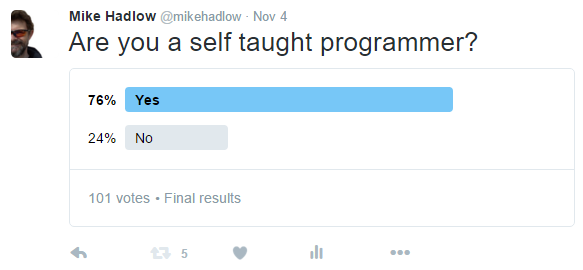
76% say they are self taught. Also interesting were the comments around the poll. This was typical:

Even programmers with CS degrees insist that they are largely self taught. Others complained that it was a hard question to answer since the rate of change in the industry means that you never stop learning. So even if you did at some point have formal training, you can’t rely on that for a successful career. Any formal course will be just a small element of the continual learning that defines the career of a programmer.
We are left with a very strange and unexpected situation. Formal education for programmers seems not to work very well and yet the majority of those who are successful programmers are mostly self taught. On the one hand we seem to have people who don’t need any guided education to give them a successful career; they are perfectly capable of learning their trade from the vast sea of online resources available to anyone who wants to use it. On the other hand we have people who seem unable to learn to code even with years of formal training.
Even for people who attended prestigious colleges, much of the actual knowledge transfer into the brain comes via self-directed practice. The money spent on the college does little to improve this knowledge transfer.
In my college computer science course, the actual education came from a foreign teacher with a heavy accent who had zero teaching ability. The value of the diploma was not the education, it was from the filtering. Only really smart students could self-teach themselves the material and get through the course. And what help was provided, was done by teaching assistants who themselves were just slightly older students. Thus the actual education being provided by my college was being done by students who themselves were net payers of tuition. What a racket.
This is a common pattern. Caltech is one of the premier high-tech education places. But again, Caltech is not spending money to transfer knowledge. It is simply giving smart students a place to self-teach themselves, while filtering out those who cannot hack it, and so that the value of the degree is maximized. One alum of Caltech writes:
When I attended Caltech, the university was notorious for “correspondence courses” in which big name faculty would deliver awful, boring, generally uninformative lectures and students would not attend but instead send tape recorders in their place. Yes this did happen.
There is a serious point in this. Many of the big name researchers at Caltech were terrible teachers for undergraduates. They skipped over key steps and concepts that they took for granted but which it was their job to teach in introductory courses. They failed to assign or perform adequate practice and drilling for basic concepts and methods that they were supposed to teach in undergraduate courses. They assigned quite advanced problems as homework and exam problems in introductory courses, problems involving subtleties of physics and other fields that students would not encounter or grasp until advanced undergraduate or graduate level courses. They used advanced problems as teaching examples in lectures in introductory courses as well. Many were simply boring — clearly not a weakness of Richard Feynman. Looking back, the terrible teaching was a major contributing factor to the high dropout rate at Caltech.
Students needed to recognize not only that the teaching was terrible, but also what was wrong and to perform a large amount of unassigned work to compensate for the gaps in the teaching for which their parents or in some cases the students were paying a lot of money.
There is a myth that top-ranked schools offer a “great education.” Rather, top-ranked schools provide an intense filtering process whereby only the top students get the sheep-skin.
Ok, but programming is unique because it doesn’t require any special equipment. Mechanical engineering, electrical engineering, etc, all require equipment not available at home.
True, but often the most cost effective approach is apprenticeship. A young adult might spend a year or two of self study to learn the math, science, and other book knowledge behind the profession. Then on the job they learn to use the equipment. This is more efficient, because you do not have to replicate the entire equipment setup in a non-commercial setting; and the equipment you use on the job will be the most relevant and up to date.
A better path forward
Let’s talk policy fixes.
Here is an easy fix: legally recognized professional associations should not be the sole determiners of the entry requirements for their profession. Existing professionals have an incentive to always make it longer and more expensive to enter the profession, because restricting entrants props up their own salaries. Thus we see bar associations and the American Institute of Architects continually tack on more years of expensive schooling to the licensing requirements.
Even better fix: revoke all laws that make college a legal requirement for entering aa profession. Entry requirements can only be based off passing exams and completing a paid apprenticeship. It is reasonable to have licensing requirements for lawyers and architects. But there is no reason to make listening to a professor a requirement. As long as you prove you have the knowledge, it need not matter if you got that knowledge from a book or from a lecture.
Since government has created this spiral of degree inflation, it may take government action to unwind it. So we may need an even harder fix: Create an alternative credentialing system whereby people can get a degree without paying for school. Students would simply have to pass tests to prove they had done the readings, solved the problem sets, and/or written worthy papers. Companies would not be allowed to prefer college diplomas to these alternative credentials.
Today, we condemn our youth to four years of soul draining high school, then four to seven more years of expensive schooling, all in order to gain the credentials necessary for a career. We can imagine a world where a motivated yet disadvantaged student could be working as an office assistant in his teens, studying the books on the side, and passing the alternative bachelors degree exam. He takes up an apprenticeship at 18, studies for the bar, and by 21 be a full-fledged lawyer, with zero college debt, and zero grad school debt.
We had that world once before, we could have it again.
Further Reading
Here are some good articles by other authors, who have noticed the same problem of degree inflation:
- College has been oversold
- Career Opportunities
- The Magic of Education
- BAAAA! Tremble Before the Mighty Sheepskin Effect
- Educational Signaling: A Fad Whose Time Has Come
- The Master’s as the New Bachelor’s
-
If you want to see a full list of people I included with the key section of their bio, see this page. To download my spreadsheet with me counting school status, see here.
↩
